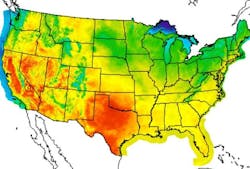Record heat putting strain on Texas Grid resiliency regardless of fuel resource
The often threatened Texas grid so far has survived record summer demand without system-wide outages, thanks not to renewables or conventional power contributions but the voluntary conservation by customers.
The Electric Reliability Council of Texas, which manages the statewide grid, has put out several appeals for reduced energy demand this week as a heat wave batters the region. On Wednesday, available peak capacity topped predicted demand by only about 1,000 MW (or 1 GW less than the approximately 79 GW possible in the generation fleet).
The close call mirrored a similar situation only two days earlier, ERCOT noted. On Monday, grid consumers reduced consumption by close to 500 MW and gave the system just enough peak capacity to spare.
“Conservation is a reliability tool ERCOT has deployed more than four dozen times since 2008 to successfully manage grid operations,” the grid system operator reported. “This notification is issued when projected reserves may fall below 2300 MW for 30 minutes or more.”
On Wednesday, dispatchable generation capacity (such as coal, gas or nuclear-powered) totaled about 67 GW at the tightest hour beginning 3 p.m. Central time. That was 84 percent of installed capacity was available during the peak challenge, according to ERCOT.
A big problem was lack of wind energy. Only 4,294 MW (or 4.29 GW) was available out of the state’s nation-leading 35.1 GW--only 12 percent-- in installed wind capacity. Nearly 8 GW of Texas’ 11.8 GW solar capacity (68 percent) was available for use on the grid, the release says.
Related Lone Star stories
Texas regulators consider new Distribution Interconnection standards for Battery Storage
Microgrid at Fort Hood Army base successfully islands from ERCOT grid
In addition to extreme heat, ERCOT cited low wind generation, higher thermal power forced outages and west Texas cloud cover limiting solar as impact factors on the grid reserve margins.
If demand exceeds generation capacity, ERCOT is forced to undertake load shedding, or cutting power to various customer areas on a rolling basis. This is what happened when 52 GW of generation capacity was knocked offline during a lingering winter storm and record cold temperatures in February 2021.
Record demand and higher commodity prices were driving up spot market prices in the ERCOT region, which is a competitive energy bidding market. Some power generation was fetching more than $5,000 per MWh on Wednesday, according to reports.
-- -- --
(Rod Walton, senior editor for EnergyTech, is a 14-year veteran of covering the energy industry both as a newspaper and trade journalist. He can be reached at [email protected]).





